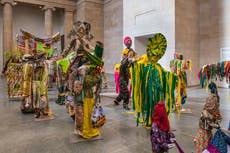Venice Biennale 2022 – British and French pavilions review: Pure aspirational uplift
Britain’s Sonia Boyce and the French-Algerian artist Zineb Sedira deliver exhilarating works with a striking generosity of purpose

If any Black British artist seems destined for national treasure status, it’s Sonia Boyce. An unfailingly positive voice since her involvement in the pivotal Black Art movement of the early Eighties, Boyce (born 1962) has created some of Tate Britain’s most popular works in paintings such as Missionary Position II, while her recent video work imports anarchic Caribbean carnival traditions into British stately homes in some of the more imaginative reflections on Britain’s vexed colonial past. Who better, then, to represent Britain in the first Venice Biennale – the “Olympics of Art” – since the start of the pandemic? It’s also the first since Black Lives Matter and its attendant explosion in awareness of Black British culture.
In Feeling Her Way, Boyce gives literal vent to the “many voices” of Black British women. Five great singers – Errollyn Wallen, Jacqui Dankworth, Poppy Ajudha, Sofia Jernberg and Tanita Tikaram – animate the British pavilion with their voices, their soaring, sighing, keening tones floating through the austere neo-classical spaces. In the first room, they’re called upon to improvise “as animals or objects” (that’s what it says in the wall text), each stretching her voice, at times almost agonisingly, as though trying to hit some note or idea that’s just beyond reach. They then extemporise solo on a piece of their own.
There’s nothing so obvious as a song here. The performances, captured on video at Abbey Road Studios (a setting that’s as iconically British now as Buckingham Palace), don’t cohere in any obvious way. It’s the sense of collective striving, of “feeling their way”, of the visitor walking into a free-form vocal jam session that’s exhilarating. As the voices come towards you from different parts of the building it’s as though a new egalitarian, multi-racial Britain is being sung into existence. If that ideal isn’t exactly new, this work – commissioned by the British Council – seems calculated to demonstrate that post-Brexit Britain is still a world leader in terms of inclusivity and cultural experimentation.
The women’s backgrounds are amazingly diverse. Dankworth, for example is the daughter of British jazz icons Cleo Laine and Johnny Dankworth. Tikaram, who had pop hits in the Eighties, is of Indian-Fijian-Sarawakian origin, while Jernberg was born in Ethiopia, but identifies as Swedish – all of which showcases the extraordinary elasticity of the idea of the Black Woman in Britain today.
There’s a complex subtext in Boyce’s geometric sculpted settings and the angular seats we sit on with their shiny pyrite surfaces. Given the name “fool’s gold” by colonialists – which renders it “other” – this material raises questions, we’re told, about “judgement by negative comparisons”. All this gets a bit lost amid the vocal clamour. And there could perhaps have been a touch more of the edge that comes with the great improvisation of contemporary British culture as it’s lived on the ground. Maybe a bit of grime inserted into the broadly jazz-soul idiom. But that would have gone against the grain of an event that goes for pure aspirational uplift – and, to a large degree, achieves it.
In the French pavilion next door, French-Algerian artist Zineb Sedira (born 1963), also mines her experience as the child of immigrants in the post-colonial metropolis, in her case Paris. Her approach, however, is more directly autobiographical. The first thing we’re shown is a rock band’s gear, looking just itching to be played. Never mind art being the new rock’n’roll, rock’n’roll seems to be the new art. A mock-up of a typical north African-French immigrant sitting room evokes Sedira’s childhood in the Paris suburbs. Occupying the central space is a fully functioning bar across which, as I enter, a soigné black-clad couple appear and do a tango to mildly befuddling effect. Where are we? Paris, Buenos Aires or a colonial Algiers of Sedira’s imagination?

Sedira’s meditation on memory, nostalgia, time and the immigrant experience comes together in a recreation of her present-day sitting room in Brixton. She has lived in London since the mid-Eighties, which doesn’t seem to affect her status as a French artist. Every surface is packed with memorabilia referencing the post-colonial past, from old Egyptian film posters to African masks. On the television, meanwhile, which we watch sitting on Sedira’s own furniture, a woman looking very like Sonia Boyce holds forth about such quintessentially British stuff as Rock Against Racism and the influence of post-punk DIY culture on Black British art. It is Boyce, of course – and in the French pavilion. What a marvellously generous gesture: to include your supposed rival from the neighbouring pavilion – and the neighbouring country – in your work. In the face of a pervasive nationalistic retrenching across Europe, nationality and identity are now so transferable that – from a purely artistic point of view – the French pavilion could easily have been the British pavilion. I was undecided by the end which of the two experiences made me feel more positive about being British.
The 2022 Venice Biennale runs until 27 November



Join our commenting forum
Join thought-provoking conversations, follow other Independent readers and see their replies
0Comments